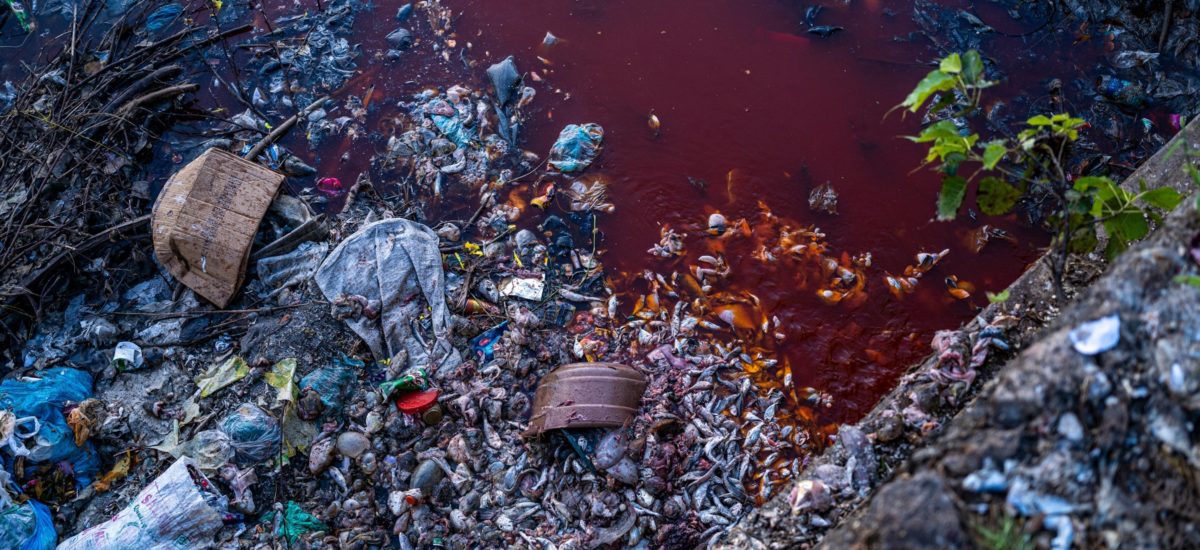Photo courtesy of Tharmapalan Tilaxan
While President Gotabaya Rajapaksa and his ministers make glib statements on their commitment to preserving and protecting the environment and Sri Lanka’s rich biodiversity, the conditions on the ground are at odds with their claims.
At the Glasgow climate change conference this week President Rajapaksa said, “As a developing tropical island nation with abundant biodiversity, Sri Lanka is deeply aware of the impacts of climate change. Our rich philosophical heritage, shaped by Lord Buddha’s teachings, places great value on environmental integrity. Sustainability is therefore at the heart of our national policy framework.”
He said the country had prioritised enhancing national forest cover and claimed to play a leadership role in mangrove restoration and conservation. “Sri Lanka’s progressive agenda on the environment is despite the resource constraints it faces as a developing nation.”
Back at home, Batticaloa MP Shanakiyan Rajaputhiran Rasamanickam charged President Rajapaksa with committing ecocide even as he talked about climate change at COP26.
“There is a massive deforestation that is happening in this country, sand miners are running havoc in this country and destroying the eco-system. Wells are drying up due to the excessive mining of sand. Whilst doing all this within the country, President Gotabaya Rajapaksa has gone to Scotland and is boasting about how Sri Lanka would be the first country to be 100% organic,” Mr. Rasamanickam said.
The country’s biodiversity and its forests are being destroyed on a daily basis for the sake of profits by big business. Mangroves are felled, wetlands are being filled, water and air is polluted and waste is dumped haphazardly. Despite repeated complaints and reports to relevant government authorities including the Environment Ministry and the Central Environment Authority (CEA), no action is taken to investigate or prosecute the breaching of environment laws and regulations. Due to political pressure and interference and corruption, officials turn a blind eye to flouting of the laws.
The Ministry of Mahaweli Development and Environment as the National Focal Point to the United Nations Framework Convention on Climate Change (UNFCCC) submitted its Nationally Determined Contributions (NDCs) at the 21st session of the Conference of the Parties to the UNFCCC in 2015.
Since then the country was moving towards policy and institutional changes to achieve the stated targets. However, the country targets were not achieved and a new document was produced. The facts and targets have been stated out of context and are realistically unachievable when it comes to sectors such as forestry and agriculture.
Forestry Sector
In the forestry sector, for example, the initial target was to go for a 3% increase in forest cover as stated in the initial NDCs submitted and that would be increase the forest cover up to 32.6 % from 29.6%. Back then the existing forest cover was actually 17-18 %.
But we have seen the highest ever deforestation rate after the current government was elected, especially under S.M. Chandrasena as the Minister of Environment and later under five ministers namely C.B. Rathnayake, Wimalaweera Dissanayake, Mahinda Amaraweera, Nalaka Godahewa and Douglas Devananda. Deforestation was carried out to sell the land to private individuals and companies without any concern for the impact of environmental degradation.
Circular 1/2020 and subsequent circulars have put almost 700,000 hectares of forest land that were under the control of Forest Department in danger by transferring the forest land to Divisional Secretariats to be used for any development activity.
The circular has resulted thousands of acres of forest land, and in the case of Siyambalanduwa tens of thousands of acres, being permanently converted to agricultural land. In the Kotawehera area more than 3,000 acres of pristine forests were cut for agriculture violating both the State Lands Ordinance and Land Development Act in addition to the violation of national Environment Act. In addition to state lands, Mahaweli lands and Land Reform Commission (LRC) lands, mostly forested and rich in bio diversity, are been converted for non-forest uses.
Mangrove ecosystems conversion began with the Anavilundawa wetland and then the Polathumodara mangrove lands were filled with municipal garbage by the Weligama Pradeshiya Sabha.
LRC forest lands belonging to planters have been given to different parties and the Sinharaja Forest’s virtual buffer is being decimated acre by acre.
Mahaweli protected areas/reserves/forests were conserved to compensate for the forest loss due to submerging of forests in the hills for large reservoirs. However, these forests and national parks are used for various activities from chena cultivation to paddy farming. Paddy cultivation inside the national park with political pressure to continue illegal farming is an example.
In addition, close 10,000 acres of Mahaweli land belonging to different Mahaweli zones are offered to businessmen to farm 10 selected crops. These are elephant habitats where thousands of other species remain intact thanks to the umbrella species such as elephants.
In Rambakanoya 5,000 acres of forests have been cut and irrigation tanks providing drinking water have been contaminated. This is another example of the abuse of Mahaweli lands, offering them to big companies creating both catchment degradation and siltation coupled with water related issues that will remain for generations. Fish deaths were seen in this area on a large scale.
Agriculture Sector
Agriculture sector emissions have increased although the pollution from agriculture has reduced due to agrochemical ban. However, there is a threat to the soil and bio diversity due to organic fertilizer from China.
Although NDCs speaks of agricultural productivity and transformation to more climate friendly agriculture, nothing has been done to achieve this yet either in terms of policy or on the ground. In the name of agriculture all types of lands belonging to different institutions of the government have converted from forests, contributing to large scale forest cover losses.
Electricity sector
The electricity sector is the only one that is progressing in terms of policy and practicality on ground. However, there is danger of large solar farms that would result in deforestation and mini hydro development that will impact bio diversity negatively.
Industrial sector
There has been no measures to address the industrial sector in terms of pollution and emissions. Industrial pollution is becoming a dangerous issue. Water and air pollution remain the most concerning areas. Recent records indicated Colombo and Kandy’s air pollution levels keep rising while major rivers such as the Kelani River continue to be polluted by the industries located in the river basin.
Waste
Municipal waste and waste issues remain the same without any policy or practical change. Almost all Pradeshiya Sabhas are dumping their waste in open dumping sites or it is used to fill wetlands. Open burning is practiced although it is prohibited by law. The Bibile Pradeshiya Sabha is dumping garbage into the Nilgala River. The Weligama Pradeshiya Sabha and the Galle Municipal Council use garbage to fill land adjoining water sources of people in the area. In some instances municipal waste is dumped in wildlife habitats and elephants feed on it.
Although some uses of plastics have been limited, plastic pollution by other sources continues to rise since the production of plastics has not reduced.
Water
All types of water related ecosystems are destroyed from wetlands, rovers, catchments and lowlands. The depletion of ground water remains a concern as well.
Muthurajawela being filled every day. Recently a Pradeshiya Sabha member of Ja Ela and Wattala was accused of filling acres of wetland without approval.
Forty acres of Baddegana wetland was given to a Hambantota bird park owner to put up an exotic bird park in the wetland, home to many native species. The Bolgoda wetland is being filled ignoring the requirement of 40 feet from the river border. No action is taken by the CEA despite several complaints.
Thalangama wetland is re-gazetted allowing an elevated highway to be built cross it. Similarly, the Gregory Lake area in Nuwara Eliya will be used for an UDA project in the name of tourism development. Almost three acres have been identified for a cable car station to be constructed.
River reservations are destroyed and no law or policy decision is taken to protect river buffer zones despite hundreds of requests. Rivers can only be protected if the catchments of rivers and buffer zones of rivers are protected.
Gem mining, sand mining and other types of mining activities are conducted in almost all rivers close to estuaries resulting salination of water in the case of the Kalu Ganga and the Kelani River. These mining activities have resulted in failed banks and water stagnation in addition to pollution.
It is clear that the president’s statements on the international stage and the reality on the ground are contradictory. As a country, Sri Lanka has a long way to go to achieve the NDCs, especially in the sectors of forestry and agriculture, as well as the UN’s Sustainable Development Goals. The president will have to ensure that the relevant ministers and heads of institutions change the way they operate at the moment in terms of protecting and preserving the environment.


